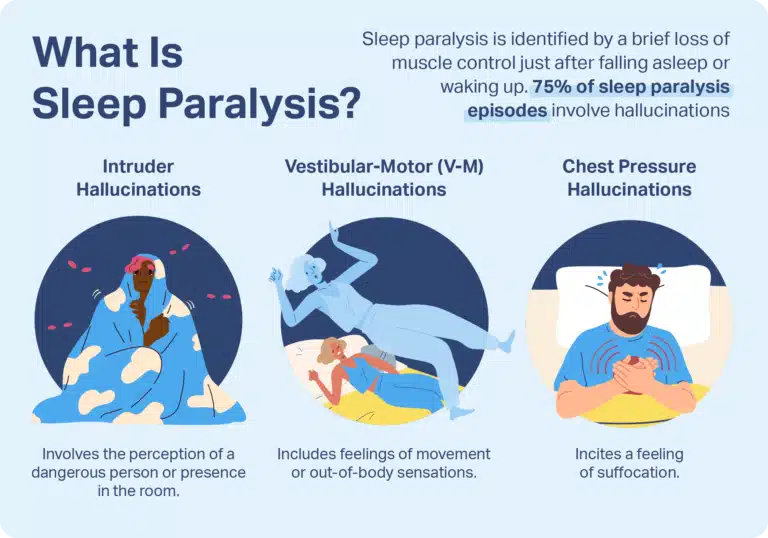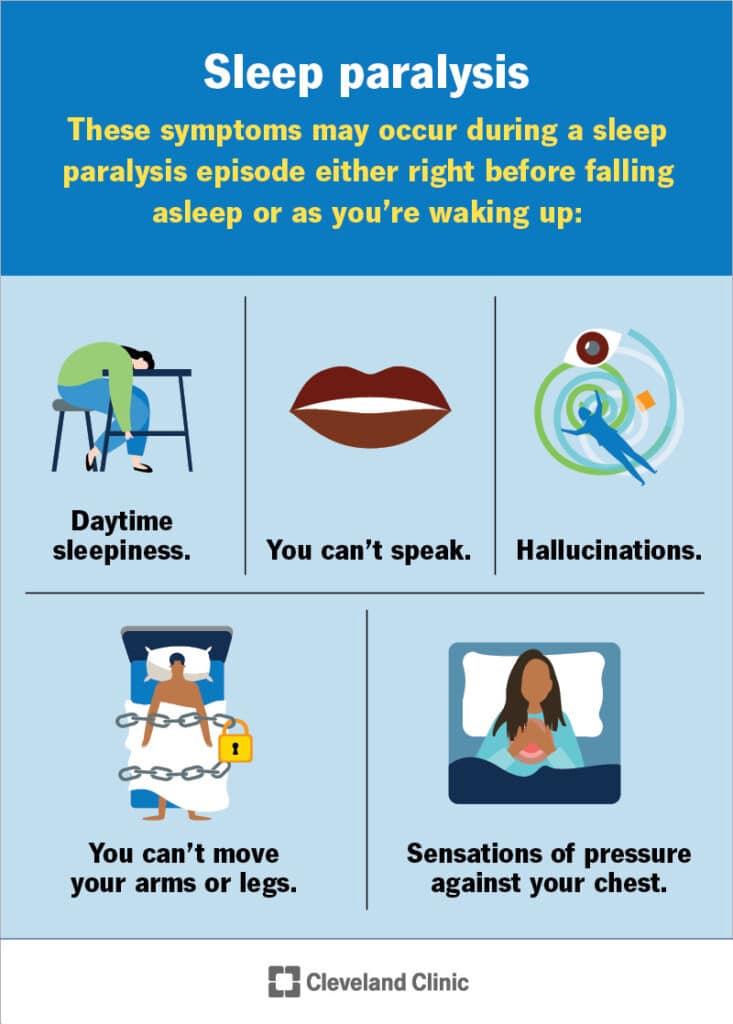Sleep paralysis is a curious and often unsettling phenomenon that blurs the line between waking and dreaming. Imagine waking up in the middle of the night, unable to move or speak, and sensing an ominous presence in your room. For some, this experience includes vivid hallucinations disturbing sights, eerie sounds, or even the sensation of being held down. It’s no wonder sleep paralysis is often described as a “waking nightmare.”
Despite its terrifying nature, sleep paralysis is surprisingly common and usually harmless. While the exact causes remain unclear, this phenomenon provides a fascinating glimpse into the complex mechanics of sleep and consciousness. In this guide, we’ll explore the science behind sleep paralysis, its potential triggers, how to prevent it, and strategies to cope with its effects.
What Is Sleep Paralysis?

Sleep paralysis occurs when you temporarily lose the ability to move or speak as you transition between sleep and wakefulness. During this time, you may remain fully conscious, which makes the experience all the more distressing.
This condition is categorized as a parasomnia, a group of sleep disorders involving unusual behaviors, sensations, or movements during sleep. Sleep paralysis is closely linked to rapid eye movement (REM) sleep, the phase where dreaming occurs. Normally, your brain paralyzes your muscles during REM to prevent you from acting out dreams. However, in sleep paralysis, this muscle atonia lingers even as your mind wakes up.
Types of Sleep Paralysis Hallucinations
One of the most unnerving aspects of sleep paralysis is the hallucinations, which can engage all your senses:
| Type of Hallucination | Description |
|---|---|
| Visual | Seeing shadows, figures, flashing lights, or even imagined creatures like demons or animals. |
| Auditory | Hearing voices, static, footsteps, whispers, or screams. |
| Tactile | Feeling pressure on the chest, being touched or restrained, or the sensation of floating or falling. |
| Olfactory | Smelling burnt toast, smoke, or rotting odors, which are often unpleasant. |
What Sleep Paralysis Feels Like
During a sleep paralysis episode, you may experience:
- Inability to move or speak: You are aware of your surroundings but physically paralyzed.
- Sensations of suffocation: Pressure on your chest or difficulty breathing.
- Fear or panic: Hallucinations often feel so real that they provoke intense emotions.
- Hallucinations: You might see or feel a presence, often perceived as malevolent.
Episodes typically last a few seconds to a few minutes and resolve on their own or with external stimuli like someone waking you up.
How Common Is Sleep Paralysis?
Sleep paralysis is more common than many realize. Research suggests that up to 30% of people experience it at least once in their lives, and 8% report recurring episodes. It can occur at any age but is most common in adolescence and young adulthood, with episodes often decreasing as people age.
What Causes Sleep Paralysis?
While the exact causes remain uncertain, several factors may increase your risk:
1. Sleep Disruptions
Irregular sleep schedules, insomnia, or shift work can interfere with your sleep cycle, making sleep paralysis more likely.
2. Mental Health Conditions
Anxiety, PTSD, and depression are strongly linked to recurrent episodes, possibly due to heightened stress levels.
3. Sleep Disorders
Conditions like narcolepsy and obstructive sleep apnea are associated with sleep paralysis.
4. Sleeping Position
Sleeping on your back increases the likelihood of experiencing sleep paralysis, as it may exacerbate airway obstructions or muscle atonia.
5. Substance Use
Alcohol, caffeine, and certain medications can disrupt sleep patterns and REM cycles, triggering sleep paralysis.
Preventing Sleep Paralysis
Though there’s no guaranteed way to prevent sleep paralysis, these strategies may help reduce its frequency:
| Prevention Tips | Details |
|---|---|
| Maintain a Regular Sleep Schedule | Go to bed and wake up at consistent times, even on weekends. |
| Practice Good Sleep Hygiene | Avoid screens before bed, keep your room dark and quiet, and establish a relaxing bedtime routine. |
| Avoid Triggers | Limit caffeine and alcohol, especially in the hours leading up to sleep. |
| Try New Sleeping Positions | Sleeping on your side may reduce episodes. |
| Manage Stress | Use relaxation techniques like meditation, deep breathing, or yoga to unwind before bed. |
Coping During an Episode
If you find yourself in the midst of a sleep paralysis episode:
- Stay Calm: Remind yourself that the experience is temporary and harmless.
- Focus on Breathing: Take slow, deep breaths to regain a sense of control.
- Try Small Movements: Start by wiggling a finger or toe to break the paralysis.
- Shift Your Thoughts: Concentrate on calming or happy imagery to counteract fear.
Sleep Paralysis and Hallucinations: Myths vs. Facts
| Myth | Fact |
|---|---|
| “Sleep paralysis is caused by demons.” | Sleep paralysis has scientific explanations related to REM sleep and brain activity. |
| “You can die from sleep paralysis.” | While frightening, sleep paralysis is not physically dangerous. |
| “Only people with mental illness get it.” | Sleep paralysis affects people with and without mental health conditions. |
| “There’s no way to stop it.” | Improving sleep hygiene and managing stress can significantly reduce episodes. |
When to See a Doctor
Occasional sleep paralysis is normal, but frequent episodes may warrant medical attention. Consult a healthcare provider if:
- Episodes are interfering with your sleep or daily life.
- You experience excessive daytime fatigue.
- You suspect underlying conditions like sleep apnea or narcolepsy.

Final Thoughts
Sleep paralysis is a fascinating and often unsettling experience, but it doesn’t have to take over your nights or your peace of mind. Understanding its causes and implementing strategies to reduce its occurrence can empower you to manage it effectively. With time, proper sleep habits, and self-awareness, you can minimize its impact and reclaim restful, fear-free nights. Sweet dreams without the “waking nightmares”.
FAQs
1. What is sleep paralysis?
Sleep paralysis is a temporary inability to move or speak as you transition between sleep and wakefulness. It often involves vivid hallucinations and can feel unsettling, but it’s generally harmless.
2. What does sleep paralysis feel like?
It feels like being “stuck” between sleep and wakefulness. You’re aware of your surroundings but unable to move or speak. Many people experience sensations like pressure on the chest, difficulty breathing, or a strong sense of fear.
3. Is sleep paralysis dangerous?
No, sleep paralysis itself isn’t dangerous. While it can be distressing, it doesn’t cause physical harm. However, recurrent episodes might disrupt sleep or indicate an underlying sleep disorder.
4. Why does sleep paralysis happen?
It occurs when the body gets “stuck” between REM sleep (where dreaming occurs) and wakefulness. Factors like irregular sleep patterns, stress, and certain health conditions can increase the likelihood.
5. Can sleep paralysis cause hallucinations?
Yes, hallucinations are common during sleep paralysis. These can involve seeing figures, hearing sounds, feeling touch, or even smelling things that aren’t real.
References
Understanding sleep paralysis, its causes, and prevention tips.
www.sleepfoundation.org
An overview of sleep paralysis and its connection to sleep disorders.
www.health.harvard.edu
Sleep paralysis symptoms, management, and prevention tips.
www.clevelandclinic.org
A detailed guide on the causes, symptoms, and coping strategies for sleep paralysis.
www.verywellhealth.com
Research-backed information on parasomnias and sleep paralysis.
www.ncbi.nlm.nih.gov
Personal accounts and scientific insights into the phenomenon.
www.thesleepparalysisproject.org

